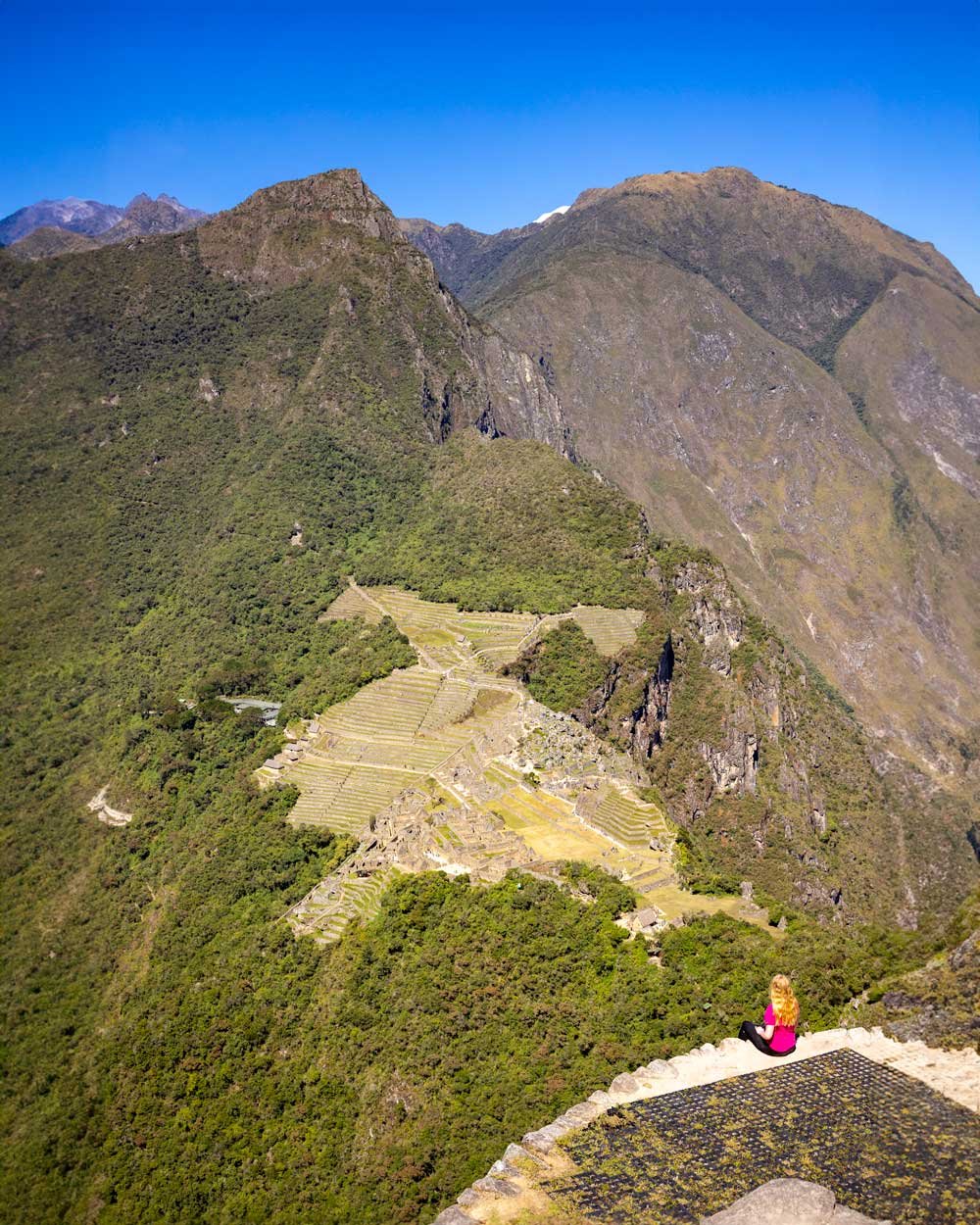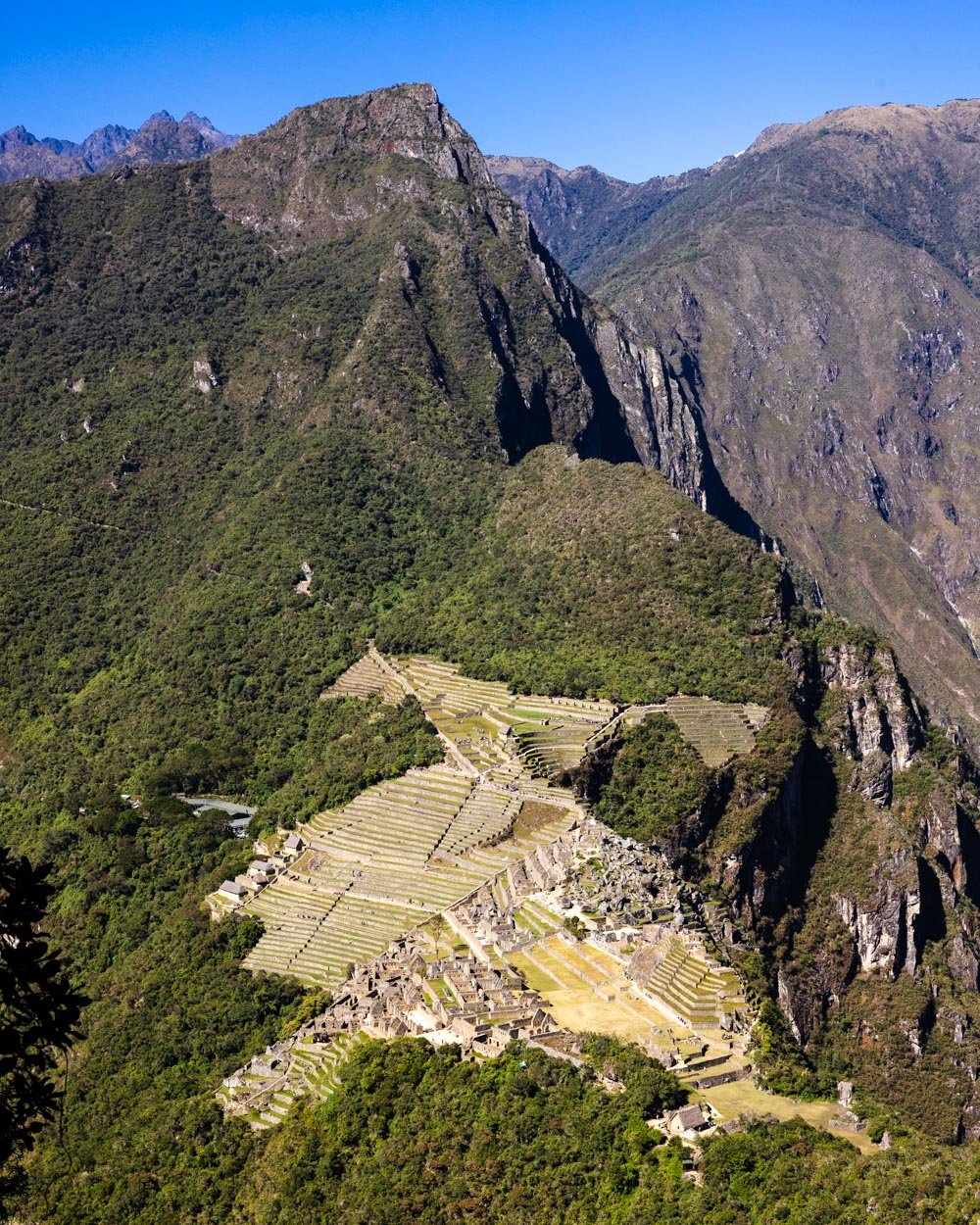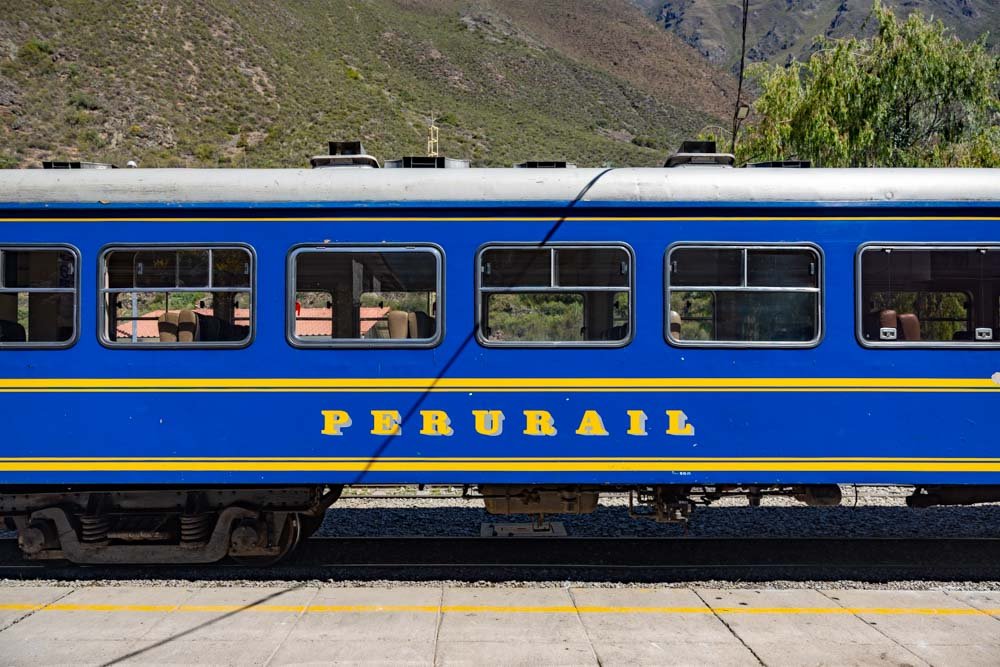The Huayna Picchu hike has to be one of the best short walks in the world. The views looking down over Machu Picchu are simply jaw dropping and it’s only when you get up this high that you can really appreciate its incredible setting, nestled on a ridge between sheer jagged mountains.
But it’s not just the scenery that makes it special, the trail itself is exciting, with narrow paths, vertigo inducing drop offs and of course the famed ‘stairs of death’.
With that said, the stairs were definitely not as scary as I thought they might be and we’ll be going into lots of detail on the track, with photos, so you can get a good understanding of what’s its really like.
Here’s everything you need to know about hiking Huayna Picchu (Wayna Picchu).
The Huayna Picchu hike (aka Wayna Picchu)
The stats
Distance: 4.6km loop (3km return on the Huayna Picchu trail, 1.6km circuit 3)
Elevation gain: 360m
Difficulty: Moderate
Summary: Once you’ve walked across Machu Picchu, which is largely flat, the trail to Huayna Picchu is uphill almost the entire way and some parts are very steep. The stairs are generally uneven, but not slippery when dry.
Much of the climb has a metal handrail for increased stability. The path is narrow for the most part, but never so narrow as to feel like you’re teetering on the edge - although this would still not be a fun walk for vertigo sufferers.
There are a few staircases on the descent which are not railed, but you can take them slowly and it’s not too bad.
Expect the whole walk to be significantly harder and maybe even a bit unnerving if wet though, so really take care if you don’t luck out with the weather.
It’s also worth noting that hiking poles are not allowed inside Machu Picchu, so you can’t use them on this trail.
A quick note on how hiking Huayna Picchu can affect your day at Machu Picchu
Before we get started on the trail details, it’s worth noting that you need to buy a ticket for Huayna Picchu in advance and it does sell out in peak season, so buy it as soon as you know your dates.
When you buy a ticket for Huayna Picchu, you are only allowed to hike Machu Picchu circuit 4. You need to take this trail to get to the trailhead for Huayna Picchu, as it is on the far side of the site.
Circuit 4 is one of two lower circuits at Machu Picchu. It is the longer and better of the two lower circuits, but it doesn’t include that famous classic viewpoint of Machu Picchu, which is located on the upper circuits (1 and 2).
That means if you are only planning on buying one Machu Picchu ticket, and that you are choosing to buy the Huayna Picchu ticket, you will miss that famous view. Now the views on the Huayna Picchu hike are simply sensational, but I know a lot of people would be very disappointed to miss that classic view, so it’s something to bear in mind.
The famous view at Machu Picchu - only accessible on circuit 1 or 2
If you don’t mind shelling out for two tickets, you can walk circuit 2 (either the general entry ticket or Inca Bridge) and Huayna Picchu in one day, which is what we did.
This will cover the best of the entire Machu Picchu site, it’s a fantastic but tiring day.
Starting the trail
To get to the trailhead for Huayna Picchu you need to walk for 850m through Machu Picchu, along the start of circuit 4. The trailhead for the mountain sits pretty much halfway along the circuit (just after the sacred rock).
It’s not flat, but there’s not much in the way of stairs and you’ll be stopping to check out the ruins as you go.
After 850m you’ll pass through the entry gate for Huayna Picchu and come to the hut where you register 90m later.
You’ll show your ticket (and sometimes be asked for a passport, although we weren’t) and you’ll sign the entry book, where you can see all the people who have already hiked that day and how long they took!
You’ll then take the path on the right which leads to Huayna Picchu (the path on the left goes to Huchuy Picchu, the smallest of the three mountain climbs you can do here).
You have a very short bit of flat track before you hit the first stairs, although they are quite shallow along this section.
This is followed by a very brief decent on well made stone stairs before the real climb begins, around 300m after you left the registration hut.
The climb begins
You’ll start climbing on uneven stone steps, some of which are quite steep. It was nice and grippy in dry weather.
The majority of the route up the mountain in the morning is in shadow, which made the climb feel much easier.
Right from the very beginning, you get some great views, but nothing will prepare you for what’s to come at the top.
As you climb the steps begin to get a bit more higgledy-piggledy, but are not too narrow and don’t feel precarious.
As it gets a bit steeper you’ll often find there’s a metal rail, which is probably more for the descent, but can be helpful on the ascent too.
Although there are tiny flat sections, for the most part it’s a stairmaster to the top.
Along this first part of the climb you are in a thin patch of forest, and it doesn’t really feel like there is a steep drop, as you have the cliff on one side and then vegetation on the other.
It’s steep, but I wouldn’t say it feels like you’re walking on a cliff edge.
Reaching the tiniest steps you ever did see
As you climb the views over Machu Picchu get better and better, it’s really quite staggering to look down on it from above and it feels gratifyingly far away very quickly.
Just over 1km after leaving the registration hut, you’ll reach a very fun and unusual part of the walk.
The narrowest steps I have ever seen in my life! Almost comically narrow and very steep.
Although they are narrow, they are quite smooth and even, and there’s a handrail most of the way up.
There’s also a little break part of the way up, as the track will lead you to a wide ledge where you can enjoy the ever expanding view.
The second half of these tiny steps gets steep enough that the majority of people (me included) will use their hands. It’s not that you’re on a cliff edge or anything, but you wouldn’t want to slip backwards.
It’s easier to get up using your hands as opposed to trying to scramble upright as the steps are so even. The steps run for about 100m and the latter part has no rail, which is why most people will use their hands.
The stairs of death
Once you’ve come up the tiny steps you’ll be at a set of wide terraces, which offer jaw dropping views of Machu Picchu and the surrounding mountains.
There is plenty of room to sit, relax and take in the majestic location.
You’ll also be right beside a ruin, which (for now at least) you can walk inside. I can imagine one day they won’t allow it, but for now it’s fine.
There’a a narrow path with a giant drop to get around to one side of the ruins, or you can walk through from the main terrace.
The narrow section has some phenomenal mountain views though and it’s flat and easy, so I would definitely go that way. I am not sure what the ruin is, but apparently the top of the mountain was originally the high priests residence.
Running along the left side of the ruins are the ‘stairs of death’. Whilst photos don’t do the stairs justice, I think Youtube videos make them look scarier than they actually are - probably in part because you used to go down these stairs, whereas now this section is one way and you climb up, which is easier than descending.
Although they are incredibly steep and have the most ginormous drop off to the left, they are quite wide and have the sturdy stone wall to the right (it’s not like Angels Landing with drops on both sides).
That’s not to say if you look down that you won’t feel like they are one crazy set of stairs, but we actually walked them a couple of times when we decided we wanted to sit longer at the lower viewpoint - and I definitely wouldn’t have done that if they were terrifying.
Of course if you are scared of heights they are going to be hideous, but otherwise I think they’re ok.
However, we walked on a bone dry day. I think the stairs would be pretty scary if wet. One slip here could potentially be a real problem, however based on a bit of Google sleuthing, no one has actually died on the stairs.
Reaching the summit
Between the Incan ruins and the large viewing platform, just under the summit of Huayna Picchu, is just 50m. So the ‘stairs of death’ are a little shorter than that to give you some idea of scale.
You’ll see the Montana Waynapicchu sign on this large platform and you’re now at an altitude of 2667.58m.
The true summit is fractionally higher, but it’s tiny and rocky, so not a great place for a signpost.
Just off to the right before you head up to the true summit is my favourite view of the entire trail. It is breathtaking and such a wow moment.
You’ll be looking down on the Huayna Picchu ruins to the right and Machu Picchu to the left, but for me it was the towering mountain range that stole the show. Some were snow-capped and all were exceptionally steep and dramatic. It really is a magical spot.
After leaving this area you have 100m more to walk to reach the official top of the mountain. There are a few stairs and then a narrow rocky section before you’ll come to the giant boulders which make up the summit.
Most are a bit awkwardly positioned and there isn’t heaps of room, so if a few people are already up there, it’s not the best place to sit.
There are some nicer, wider spots as you start to descend. The views are great, but for me not quite as good as the one just before the top or lower down the trail.
The descent
The first 300m of the descent are one way. From the top you’ll climb down a little wooden ladder inbetween the boulders and through a tiny cavern.
From here there are a few steep sets of stairs, none of which are railed. The trail continues along the terraces, with views over to the valley where Aguas Calientes sits far below.
At this point, you’ll walk down some more stairs and have to slither through a very narrow slot (cave).
It’s so narrow that you’ll have to contort to get through it - it’s very short, but requires a bit of awkward manoeuvering.
At the other side of the slot and roughly 150m after leaving the summit, you’ll reach a wide open viewing platform.
The view is terrific, but the plastic matting on the platform means that it doesn’t feel quite so dramatic as some of the earlier spots along the trail.
After this there are a few very steep stairs (but not beside a drop) and then you’ll rejoin the main trail again.
The steepest bits tend to be railed, so it’s not too difficult, but you will likely feel it in your legs afterwards as it is relentlessly downhill. That is until right at the end when you have that nice little bit of uphill to finish off : )
Once you pass the registration hut you have 700m to walk through Machu Picchu to the exit. The walk back passes by the Temple of the Condor, which currently is only open between 10am and 1pm due to restoration work.
From here, the trail then heads to the terraces near the entrance of Machu PIcchu.
Huayna Picchu vs Machu Picchu Mountain
I won’t go into too much detail here as we have a whole guide dedicated to answering this question, however, in short I’d say that Huayna Picchu is easier than Machu Picchu Mountain.
It has significantly less elevation gain and it’s a fair bit shorter too. More of the trail is in the shade, which can make a big difference if you have a clear day.
Huayna Picchu has a few more exposed sections, but Machu Picchu Mountain isn’t completely devoid of it’s own steep drops from unfenced cliff edges!
Both have wonderful views, although Huayna Picchu gives you a closer view of Machu Picchu from above and has a more exciting path.
The views from Machu Picchu Mountain
Huayna Picchu Mountain opening hours and entry fee
At time of writing the Huayna Picchu ticket, which includes circuit 4, is 200 soles per person (approx USD $53). Tickets are limited and sell out in peak season.
There are currently four time slots, 7am, 8am, 9am, 10am and 11am. You can enter Machu Picchu up to one hour before your mountain time slot and climb the mountain anytime within your specified time slot.
They actually let us onto the trail before our time slot, so if you are early it’s worth heading across to see if you can get in earlier.
Getting to the Huayna Picchu trailhead
From Aguas Calientes you can take the steep hiking track or the 20-25 minute bus ride up to the Machu Picchu entry gate. You use the bottom entry gate, to the right of the toilets. Bring your passport just incase they check, they only checked ours once (and we visited three times), but don’t risk not having it with you.
Once inside the site, follow signs for circuits 4. Stop along the way because there’s a one way system on all circuits at Machu Picchu and you can’t backtrack, so this is the only time you will see this part of the site.
The registration hut is 940m from the entry gate. Once you have entered Machu Picchu on a Huayna Picchu entry ticket you can not re-enter the site, so only exit once you’ve seen everything you want to see.
Facilities at Machu Picchu
There are no toilets inside the site. You can only use the bathroom at the entry gates and the cost is 2 soles. You’ll also find a cloakroom here where you can store luggage if necessary.
No food is allowed inside the site. There is a cafe at the entry gate and also a buffet restaurant which serves lunch for around USD $40. The cafe is not cheap by Peruvian standards, but it’s cheaper than the restaurant at least! Expect a can of fizzy drink to be around USD $2.50.
This post may contain affiliate links, meaning at no additional cost to you, we will earn a small commission if you click through and decide to make a purchase. This helps towards the costs of running our website. Thanks for your support.

























































